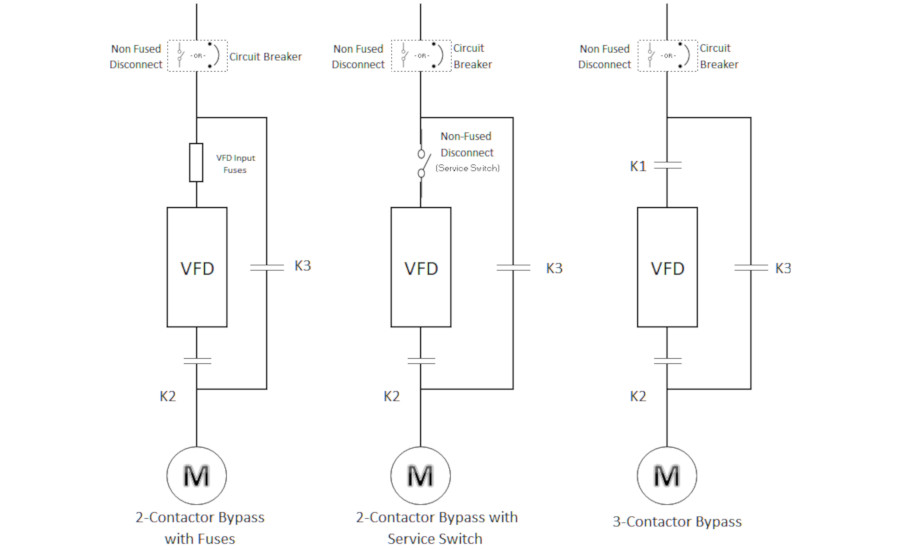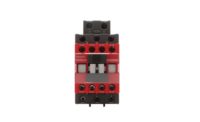Since as early as the 1990s, there have been questions, discussions, and application notes on the topic of using a 2-contactor bypass or 3-contactor bypass with variable frequency drive (VFD) configurations.
This article will offer information on topics of “safety” and “reliability” issues when using a 2-contactor or 3-contactor bypass. In order to better understand these issues and configurations, we will first review the purpose of a bypass. A VFD bypass package addresses the need to run the motor directly across the line. Using contactors, the bypass package redirects the 3-phase AC line voltage around the VFD and directly to the motor. This removes the VFD from the circuit. A common purpose for this type of package would be to allow the motor to run when there is a problem with the VFD.
In the schematic that accompanies this article, the diagram on the left (Figure 1) depicts a 2-contactor bypass with fuses. The middle diagram (Figure 2) depicts a 2-contactor bypass with a non-fused disconnect (service switch), and the diagram on the right (Figure 3) depicts a 3-contactor bypass configuration. K1 = VFD input contactor, K2 = VFD output contactor, and K3 = bypass contactor. Non-fused disconnect or circuit breaker are possible options within the bypass package. We will now address “Safety” and “Reliability.”
SAFETY
“Is a 2-contactor design safer than a 3-contactor design?”
Some have proposed that the 2-contactor with non-fused disconnect (service switch) bypass design is “safer” than 3-contactor designs, because for the purposes of VFD maintenance while running the motor in bypass, an NEC-recognized, lockable, physical disconnect is safer and more reliable than a contactor.
This is referring to the possibility that a contactor could get mechanically “jammed,” have welded contacts; have voltage accidentally applied to the coil (causing the contactor to unexpectedly “pull in,”), or even have the plunger accidentally pushed while servicing the VFD with the motor running in bypass.
While there is nothing technically wrong with the statement above, it is critically misleading. The entire argument implies it is acceptable to be performing service on a VFD while running the motor in bypass.
Unless wearing approved PPE as required by NFPA 70e and the company’s procedures, no one should be performing service work on a VFD that is still wired to a bypass package that is “ON” and running in bypass.
If a VFD from a bypass requires maintenance or repair, qualified service personnel should power down the package and then observe proper lockout/tagout procedures upstream, remove the VFD to work on it elsewhere, and then re-apply power to run the motor in “bypass.”
Conversely, a 3-contactor bypass proponent might argue that the existence of a non-fused disconnect (service switch) in a 2-contactor bypass could imply that it is safe to work on the VFD in that package while the motor is running in bypass. This opens up the possibility that the user could unknowingly place him or herself in an unsafe environment.
It should also be noted that one more important safety benefit offered by 3-contactor bypass designs that 2-contactor designs do not offer is that in a 3-contactor design, if the VFD fails to where it causes a fault between input phases, a 3-contactor design can still function with less operator intervention by electronically opening the K1 VFD input contactor, thus providing more reliability and run possibility.
Regarding the proposed statement that, “a 2-contactor with non-fused disconnect (service switch)” design is safer than a 3-contactor design,” some may conclude that it is not safer.
As a follow up question, some could ask, “Is it possible that a 3-contactor design is safer than a 2-contactor design?” For some, the answer to that question is yes. For example, the user may wish to run the motor in bypass and have power removed from the input of the VFD. With a 3-contactor bypass configuration, this simply means, on the outside of the enclosure, pressing the “bypass” key on the touchpad controls, or in a mechanical style, flip the drive/test/bypass switch into the “bypass” position. This would not require wearing approved PPE.
In a 2-contactor with fuses, or in most 2-contactor with non-fused disconnect (service switch) configurations, this will require opening the door of the package to either remove VFD input fuses or manually actuating the “service switch” to be able to run the motor in bypass while having the VFD removed from input power. Either of these actions in 2-contactor bypass configurations may put the user at risk of potential electrical shock if they are not wearing approved PPE as required by NFPA 70e and their company’s procedures.
Next, we will address reliability comparisons of each.
RELIABILITY
“Is a 2-contactor design more reliable than a 3-contactor design?”
Some have proposed that the 2-contactor design provides a more reliable bypass than 3-contactor designs. This proposal is related to potential issues with the K1 VFD input contactor, which is the input contactor to the VFD. The claim is that this contactor is subject to all the issues that exist with a 3-phase contactor that utilizes a single-phase 115 VAC coil fed from a step-down control transformer within the panel. Of course, the other two contactors are also exposed to the same issues. The argument used involves a “brownout” condition. In this condition, the line voltage – whether it be 208 VAC or 48 0VAC – drops low. The resulting 115 VAC coming off the secondary side of the control transformer can potentially drop below the “hold-in” level of the contactor coil. When this occurs, the contactor is subject to a “chattering” condition potentially leading to either welded contacts or a burned out holding coil causing the contactor to fail in the “open” condition. However, the 2- and 3-contactor bypass packages offered by various manufacturers will de-energize the coils of the contactors (sparing them from potential damage) when there is a voltage phase imbalance, phase loss, or a brownout condition and alert the user of the condition on the keypad display. In most cases, this can be done without the use of expensive phase monitor relays and interlocks.
In the initial conditions just described, the 2-contactor and 3-contactor bypass designs may be considered equally reliable. Are there other measures of reliability? Yes. In many HVAC applications, especially in the summer months, it’s not uncommon to find VFDs with bypass in HVAC systems trying to keep up with cooling on extremely hot days, fully running in bypass mode. In 3-contactor designs that are running the motor in bypass, the default state is to have the VFD input contactor open, keeping the VFD itself completely isolated from power. This not only saves the energy used to keep the drive running at idle, but also, in the event of an extreme power fluctuation that could have damaged the VFD when running in bypass, the VFD typically remains undamaged. In rare instances, a contactor, contactor coil, or even a panel printed circuit board (not in the VFD itself) gets damaged, but the VFD remains undamaged. In both the 2-contactor with fuses and the 2-contactor with non-fused disconnect (service switch) configurations, where the VFD is subject to line voltage even while the motor is running in bypass, a significant surge has greater potential to damage the VFD.
Regarding the question, “Is a 2-contactor design more reliable than a 3-contactor design,” some could conclude that the 2-contactor bypass design is not more reliable than the 3-contactor bypass design. In some circumstances, 2-contactor bypass designs could actually be viewed as less reliable.
CONCLUSION
Safety and reliability are important factors, but when choosing between a 2-contactor bypass design or a 3-contactor bypass design, it is based primarily on user preference. When safe and approved practices with main power and power electronics are followed, the two methods are safe. The same can be said for reliability. Some manufacturers may only promote a 2-contactor bypass design, while others may only promote a 3-contactor bypass design. Some manufacturers offer both designs based on user preference. The 2-contactor bypass and 3-contactor bypass design methods are both safe and reliable, and neither is superior or inferior to the other.





